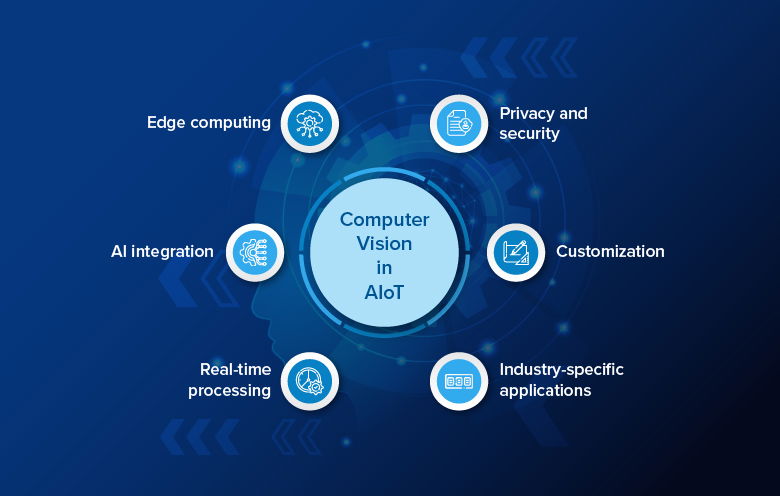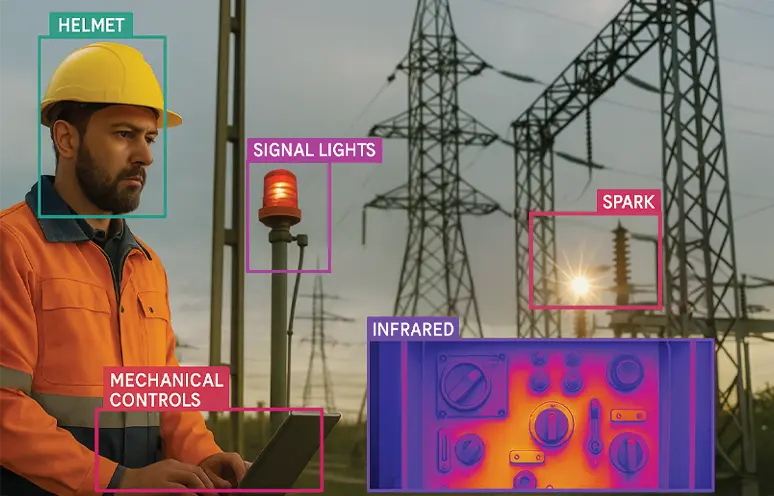Are you ready to witness the transformative potential of computer vision? It has revolutionized industries like manufacturing, healthcare, retail and automotive. Although its true impact on our lives and work has only just begun. You must prepare for a paradigm shift that will redefine what’s possible. Embrace the future today and unlock new realms of productivity and innovation.
Computer vision is a field of artificial intelligence (AI) that deals with the computers’ ability to interpret and comprehend digital images. In the past, it was mainly used for tasks such as facial recognition and object detection. However, recent advances in AI and IoT have led to the development of innovative computer vision applications.
Advances in AI, the Internet of Things (IoT) and 5G are creating new opportunities for computer vision. This is useful in AIoT, where it can be used to improve the accuracy and efficiency of industrial processes.
In this blog post, we will explore the trends that are driving the future of computer vision in AIoT. We will also make some predictions about the potential AIoT applications in the future.
AI in computer vision market predicted to touch USD 168.8 billion with a CAGR of 34.32% by 2030 – Market Research Future (MRFR)
What is AIoT?
AIoT stands for artificial intelligence of things. It is a combination of AI and IoT technologies that help you gain insights and make real-time decisions based on the data collected by IoT devices. AIoT has the potential to transform industries by enabling predictive maintenance, improving product quality, enhancing customer experiences and optimizing operations. It involves the use of various technologies such as sensors, cloud computing, machine learning (ML) and natural language processing (NLP) to create intelligent and connected systems.
The role of computer vision in AIoT
Computer vision is one of the main components of AIoT, as it provides means to obtain, analyze and interpret data from connected devices. It can help machines respond to complex problems by providing them means to recognize objects and understand their context.
Computer vision can automate complex tasks such as quality control, production line efficiency, dynamic instruction and preventive maintenance as it provides the ability to identify and analyze objects. However, companies are only just now realizing the potential applications of computer vision in AIoT. We will see an increase in the use of computer vision in industrial settings very soon.
Key trends and predictions for computer vision in AIoT
As the world of AIoT continues to expand, the role of computer vision is also increasing in various industrial settings. Here are some computer vision trends and predictions in AIoT:
1. Edge computing: A growing trend is the use of edge computing to process visual data locally, closer to the source. This reduces latency, increases processing speed and minimizes bandwidth requirements, making AIoT systems more efficient and cost-effective.
2. Integration with other AI technologies: Computer vision will increasingly be integrated with other AI technologies, such as NLP and ML, to create more sophisticated and intelligent AIoT systems.
3. Real-time processing: Real-time processing of visual data has become extremely important, enabling AIoT systems to take actions in real time.
4. Privacy and security: With the increasing use of AIoT systems, the focus on privacy and security has suddenly increased. This involves implementing measures such as data encryption and secure communication protocols to protect visual data and prevent unauthorized access.
5. Customization: With advancements in computer vision technology, AIoT systems have become customizable, which enables you to create bespoke solutions that meet your specific needs.
6. Industry-specific applications: Computer vision will be increasingly applied in industry-specific applications, such as healthcare, retail and transportation, to provide more tailored solutions that address specific challenges.
This technology has the potential to revolutionize several business operations. It enables machines to interpret visual data and make intelligent decisions in real-time and drive advancements in a wide range of industries.
The latest developments in computer vision technology and their impact on AIoT
The latest developments in computer vision technology include:
- Advances in deep learning algorithms
- Improved edge computing capabilities
- The emergence of 3D vision
- The integration of computer vision with other technologies such as robotics and IoT
- Tracking capabilities
Additionally, there have been improvements in NLP and its ability to extract information from unstructured data. These advancements have enabled computer vision technology to be used in diverse industries such as manufacturing, healthcare retail and transportation.
Game-changing results: Unveil our client’s extraordinary use of computer vision!
The effect of the increasing use of deep learning algorithms on computer vision
Deep learning algorithms are revolutionizing computer vision in AIoT, as they can identify complex patterns in visual data that traditional computer vision algorithms cannot. They improve accuracy and performance in object recognition, image segmentation and object detection applications. Deep learning algorithms are useful for real-time processing of large amounts of visual data, enabling AIoT systems such as autonomous vehicles to make decisions and take actions in real-time.
The significance of edge computing for computer vision in AIoT
Edge computing has become increasingly important in AIoT and computer vision for several reasons, like:
- It enables real-time decision-making, which is often required in AIoT systems that use computer vision.
- It reduces the amount of data that needs to be sent over the network, resulting in lower bandwidth requirements and reduced latency.
- Storing and processing sensitive visual data on local devices can improve security.
- It reduces the cost of AIoT systems by reducing the amount of data that needs to be sent to the cloud for processing, resulting in lower cloud infrastructure costs.
- It allows for greater flexibility in AIoT systems, as processing can be performed on local devices regardless of whether they are connected to the cloud or not.
Edge computing enables real-time quality control checks, improving production efficiency and reducing errors. The growing importance of edge computing in computer vision drives the development of specialized chips and processors for powerful and efficient AIoT systems.
The advent of predictive maintenance for computer vision in AIoT
Predictive maintenance is a technique used in AIoT to predict equipment failure, enabling maintenance to be scheduled before a breakdown occurs. Computer vision algorithms can be used to detect potential issues with machines in a factory by analyzing images or video feeds of the machines. The algorithms can be trained to recognize patterns and anomalies in the images. These patterns indicate issues such as overheating, malfunctioning parts, or other signs of wear and tear.
In a manufacturing plant, computer vision algorithms can help monitor the condition of machinery and equipment visually. They can detect defects and schedule maintenance before the machines fail. The development of advanced computer vision algorithms is driving the emergence of predictive maintenance for computer vision in AIoT. This enables more effective and efficient maintenance scheduling.
The rise of quality control for computer vision in AIoT
Quality control in AIoT uses computer vision to monitor and maintain production quality. Computer vision algorithms analyze visual data to detect defects in products and parts, allowing corrective action to be taken before defective products reach consumers. This can be used in industries such as manufacturing, pharmaceuticals and food processing to detect defects like cracks and blemishes.
Computer vision can also monitor the production process in real-time, detecting issues like machine failures or environmental changes. This approach reduces the risk of product recalls, improves customer satisfaction and reduces waste. Advanced computer vision algorithms are being developed to detect and classify defects, improving production efficiency and product quality.
Another use case for computer vision is number plate recognition. You can read about ANPR with computer vision in detail in our blog.
How Softweb Solutions can help you get started with computer vision
Softweb Solutions can provide best-in-class computer vision solutions for your specific needs. We develop custom software solutions to enable computer vision capabilities and integrate them into existing systems or develop new ones.
Additionally, we provide data management and analysis services to help you make the most of the data gathered through computer vision. With our expertise in computer vision and AI, we help you implement solutions that improve efficiency, reduce costs and enhance customer satisfaction.
By leveraging the latest AI advancements, we can help you achieve exceptional precision and speed. We use explainable AI to ensure decision-making is transparent and we understand how AI systems operate. AI computer vision can benefit from 3D computer vision’s breakthrough potential. The result will be ground-breaking insights and extraordinary results.
Implement computer vision to generate better ROI
Computer vision is playing an increasingly important role in AIoT. It drives the development of advanced algorithms and applications that enable businesses to monitor, maintain and improve operations across a wide range of industries.
The use of computer vision for quality control and predictive maintenance is providing businesses with valuable insights into their operations, helping to reduce costs, improve efficiency and enhance customer satisfaction.
We are one of the leading technology consulting and development companies that can help you get started with computer vision. We provide a range of services, from consulting to custom software development and data analysis. With our expertise in AI and computer vision services, we can help you stay ahead of the curve and achieve your goals in this rapidly evolving field.


